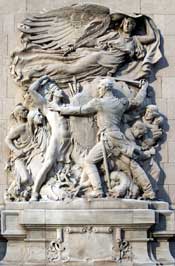Fort Dearborn - Illinois Historic Site

THE BATTLE OF FORT DEARBORN
On March 9, 1803, Secretary of War Henry Dearborn wrote to Colonel Jean Hamtramck, the commandant of Detroit instructing him to have troops survey the route from Detroit to what would later become the city of Chicago. Construction of a fort was completed by the Summer of 1804. The bastion consisted of a log-structure enclosed in a double stockade with two blockhouses. The fort was named Fort Dearborn to honor the Secretary of War, who had commissioned its construction. During the War of 1812, General William Hull ordered the evacuation of Fort Dearborn in August 1812. Local commander General Heald oversaw the evacuation, but on August 15 the evacuees were ambushed by about 500 Potawatomi Indians who slaughtered 86 people in what was subsequently called the Fort Dearborn Massacre. The Potawatomi captured Heald and his wife and ransomed them to the British. The Indians later burned the fort to the ground. The loss was one of a series of disasters our nation endured during the fight against the British.
Following the war, a second Fort Dearborn was built in 1816. American forces garrisoned the citadel until 1823, when peace with the Indians led their position to be deemed unnecessary. A temporary abandonment lasted until 1828, when it was re-garrisoned following the outbreak of conflict with the Winnebago Indians. The fort was closed briefly before the Black Hawk War of 1832. In 1837, the fort and its reserve, including part of the land that became Chicago’s Grant Park were deeded to the city by the Federal Government. In 1855 part of the fort was razed so that the Chicago River could be dredged, straightening the bend in the river. A few years later a fire destroyed almost all of the remaining buildings, but the fort's tower bell was rescued from the remains. The blockhouse and a few surviving structures were completely destroyed in the devastating Chicago Fire of 1871.
Fort Dearborn was located at what is now the intersection of Wacker Drive and Michigan Avenue at the foot of the Magnificent Mile. Due to its importance in the events of the War of 1812, part of the fort’s outline is marked by plaques and a line embedded in the sidewalk and road near the Michigan Avenue Bridge and Wacker Drive. A few timbers from the old fort were retained and are now in the Chicago History Museum. In 1933 at the Century of Progress Exhibition a detailed replica of Fort Dearborn was erected as a fair exhibit. In 1939, the Chicago City Council added a fourth star to the city flag to represent Fort Dearborn. The site of the fort was designated a Chicago Landmark on September 15, 1971.
Today the Battle of Fort Dearborn is memorialized with a sculpture by Henry Hering called Defense that is located on the south western tender's house of the Michigan Avenue Bridge (which partially covers the site of Fort Dearborn). The Fort no longer exists.
